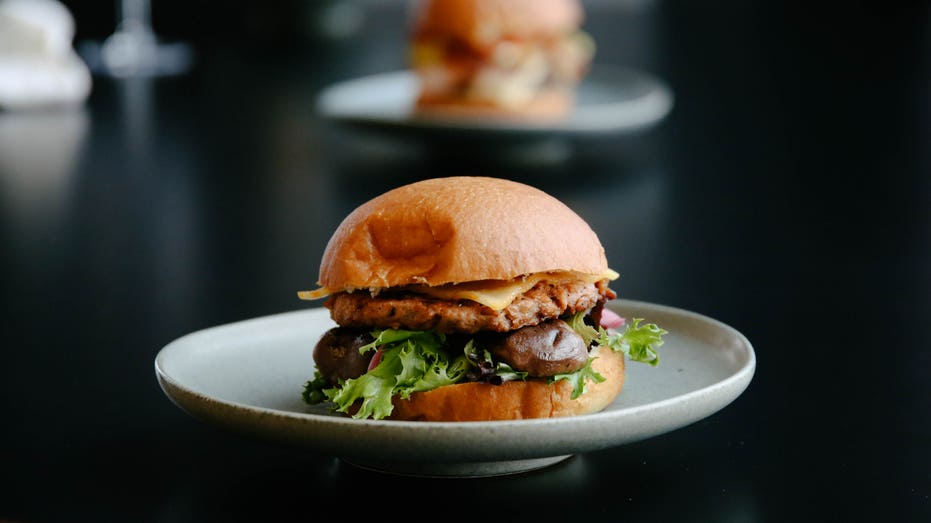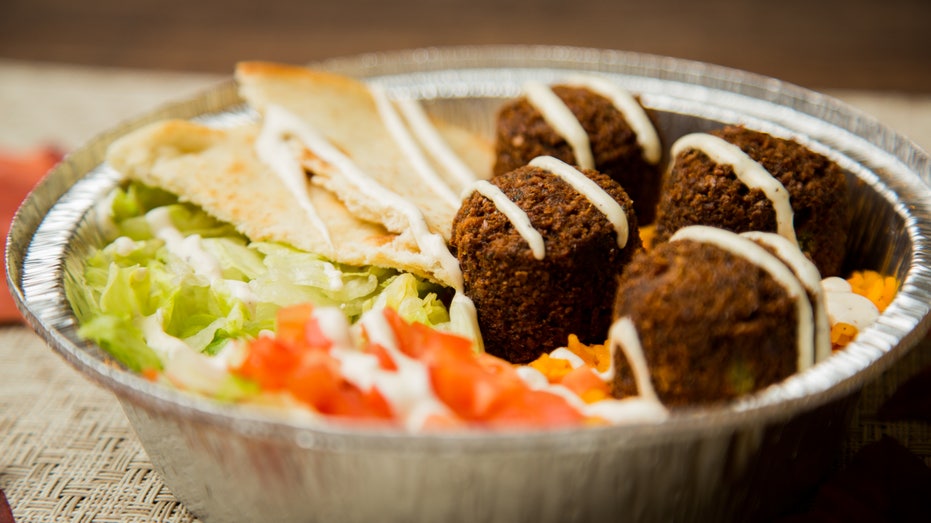Food delivery from ghost kitchens brings restaurant-quality food to the masses
The Business of Food explores the rapidly changing $1.5 trillion food industry every Tuesday on FOX Business.
The cost of running a restaurant in America is driving many business owners to rethink delivery.
New York City-based restaurateur Barry Dry started a delivery-only burger business within his existing brick and mortar breakfast cafe Hole In The Wall to help offset the $19,000 a month he spends on rent to run two locations in Manhattan.
He launched the virtual restaurant Ghost Burger last month with a small menu comprised of burgers and wings that cost between $12 and $14. He spends $1,500 a month to market it online, and enlisted third-party delivery services like Seamless and Grubhub to deliver the burgers to customers.

The Power Plant burger from Ghost Burger, a virtual kitchen that does delivery-only. (Courtesy of Ghost Burger).
"I'm utilizing the kitchens I already have to increase revenue without diminishing my other business," Dry told FOX Business.
The third-party delivery services take between 20 and 30% of his costs to deliver food, but Dry said since he's not paying for extra rent or staff, he can afford to do it. He said he makes between $500 to $1,000 a week just on Ghost Burger delivery and churns out around 10 orders per day.
More restaurant owners like Dry are using delivery-only models to reduce overhead costs like employment and rent as an affordable way to grow a business as more eaters rely on food ordering apps to get meals on-demand.
The Halal Guys, the New York City-based food cart turned national franchise known for its chicken gyros, beef and rice platters, wanted to expand its delivery reach to become more accessible to eaters outside of major cities. So it teamed up with third-party delivery service DoorDash to start cooking and delivering food out of the delivery app's new virtual kitchen, a shared space where chefs can cook and prepare their food and have it delivered. The hub, called DoorDash Kitchens, also features eateries like Thai chicken shop Rooster & Rice, diner chain Nation’s Giant Hamburgers and ice cream shop Humphry Slocombe operating in Redwood California offering delivery or pick-up in 13 suburban markets in the Bay Area outside of San Francisco.

The Falafel Platter from The Halal Guys. (Courtesy of The Halal Guys).
“We still want to have the restaurants, but we wanted to reach more customers,” Ahmed Abouelenein, the CEO of Halal Guys, said.
Abouelenein said 30% of the Halal Guys business is delivery. So downsizing to a virtual kitchen made sense. He said the kitchen can serve up to 350 customers a day.
CHAMPAGNE WITH THAT CHEESEBURGER? SPARKLING WINE BARS MIX THE EXOTIC WITH THE EVERYDAY
Sixty percent of consumers used a third-party delivery service such as DoorDash or Grubhub for delivery orders, according to a survey from the National Restaurant Association and market research firm Technomic Inc. And the demand has motivated restaurateurs to ramp up their delivery efforts without having to shell out thousands of dollars in real estate, permits, and staffing costs. The average cost of leasing a restaurant space in the U.S. is $495,000 a year, or $735,000 to buy, according to a 2018 survey from Smallbiztrends.com.
After establishing a customer base at its brick-and-mortar restaurant Rooster & Rice in San Francisco, chief financial officer Min Park said having a ghost kitchen to deliver food was a way to scale the business to suburbs in the Bay Area. He estimates it will make up 25% of the business at a fraction of the cost since the ghost kitchen requires 70% less staffing. Some days, delivery orders have surpassed the number of orders out of the San Francisco-based restaurant’s brick-and-mortar locations, Park said.
“San Francisco is one of the most challenging places in the entire country to open a restaurant. If you have a full service or fast-casual restaurant, you need to have 'X' amount of front of house staff and 'X' amount of people working in back of house. Right now, it’s just a kitchen where we get the order, make sure it’s made right and distribute it,” Park said.
Consumers spent $10.2 billion on delivery services in 2018, that’s up 42% from the year before, according to data from management consulting company Technomic. The trend toward better quality food delivered at an affordable cost started around the recession, restaurant consultants say, when diners lost disposable income to spend on eating out.
"During the recession, fine dining restaurants started to shutter and fast-casual began to thrive with providing good quality food for an affordable price," restaurant consultant Jason Kaplan said. "People's palates have definitely become more developed within the past 20 years."
A number of companies have been opening ghost kitchens. Kitchen United allows chains or restaurants to expand their outreach without having to sign a lease and hire new staff. Then there’s CloudKitchens founded by Travis Kalanick, the co-founder of ride-hailing app Uber.
The challenge of going straight to a delivery-only model is building a customer base. Celebrity chef David Chang's delivery-only restaurant Ando shuttered just two years after it launched in 2016. And Maple, another delivery-only venture Chang invested in, also shut down in 2018.
"It's really hard to start a brand without a brick and mortar," Dry said, of being hesitant to invest in a ghost kitchen model outside of his own restaurants. He said the plan is to scale Ghost Burger's delivery business first, and then have a retail presence.
UBER EATS TEST DRIVES THIS NEW FOOD REVENUE STREAM
Still, virtual restaurants may help small business owners streamline delivery costs. Many restaurants use multiple third-party delivery services and must pay commission fees to each, sometimes between 20 to 30% of the total order cost. Kaplan said its more for marketing than boosting bottom lines.
"Small business owners aren't doing it for the margins, they're doing it because they hope it will put them out there and bring in more people to the restaurant," Kaplan said.

The Business of Food explores the rapidly changing $1.5 trillion food industry every Tuesday on FOX Business.




















![‘Bar Rescue’ host Jon Taffer argues ‘in today’s world [restaurants] just have to be in that delivery marketplace.’](http://media.foxbusiness.com/BrightCove/854081161001/201909/2576/854081161001_6087065571001_6087048539001-vs.jpg)